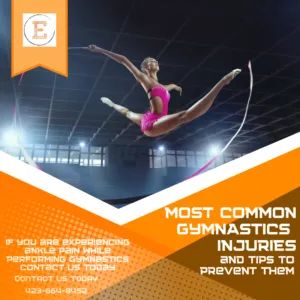“Everything is about your movements and precision and timing, which is what gymnastics is about.” – Shawn Johnson.
Gymnasts need to have both strength and grace. They focus on making their bodies appear elegant when performing a technique after they have learned to master it. Gymnasts use both their arms and legs, placing practically every joint in their bodies at danger for injury. Bruises and scrapes are two common gymnastics injuries that are unavoidable.
Gymnasts must continually train for the difficult physical and emotional toils that the sport involves. The risk of harm rises as routines get more complicated. Ankle, foot, lower back, knee, wrist, and hand injuries are the most frequent, frequently as a result of overuse or just stress. Although injuries are rarely serious, they can cause persistent pain and bone fractures if they are not addressed.
Most common gymnastics injuries
1. Labral Tears
- Any gymnastic maneuver can cause a labral tear, but ring and bar experts seem particularly susceptible. It is characterized by pain that at first goes away but often returns after returning to exercise.
2. Wrist Sprains
- Gymnastics subjects the wrist to stresses that can be greater than double the body weight. Reducing an athlete’s training load, symptom relief, and restriction to pain-free activities are the first steps in treating wrist pain.
- After an injury, gymnasts should avoid significant strain on the wrist joint for six weeks.
- Using a brace or cast to temporarily immobilize the wrist may be beneficial if the gymnast is suffering pain when engaging in activities of daily living other than gymnastics.
3. Anterior Cruciate Ligament (ACL) Injury
- When a gymnast lands “short” or is over-rotated during falls, descends, or vaults, an ACL injury may result. Within hours, there is a “pop” that can be felt or heard, followed by knee swelling.
- ACL injuries are frequently confirmed with MRI.
- Gymnasts who want to return to full involvement in sports are advised to undergo ACL reconstruction, much like athletes in other sports.
4. Achilles Tendons
- Because jumping and landing repeatedly puts stress on the Achilles tendon, which is directly above the rear of the heel, gymnasts are susceptible to a number of problems.
- Calf pain brought on by Achilles tendinitis gets worse when you jump and land. Ultrasound, stretching, activity modification, and calf exercises should be the main components of the initial treatment.
- Foot immobilization for seven to 10 days may be effective for severe symptoms.
5. Foot and Ankle Injuries
- Gymnastics is prone to foot and ankle injuries. Sprains, which can be minor or catastrophic, are frequently the result of acute injuries. A more significant injury is indicated by swelling, bruising, and discomfort right over the bones.
- Little injuries often only cause minor swelling and pain on one side of the joint. While returning to involvement after a small injury can frequently happen within a week provided there is no discomfort (or limping) with weight bearing activities, serious injuries require review by a skilled expert.
- Recovery can be aided and the possibility of reinjury decreased with protection from taping or a brace. Recurrent injuries or persistent ankle pain are common.
6. Lower Back Injuries
- Muscle strain, ligament sprain, fracture, and/or disc problems can all be the root of low back discomfort. Low back discomfort frequently gets worse with movement, especially extension movements like hunching your shoulders back.
- Gymnasts’ low back pain from strained muscles or sprained ligaments typically gets better with rest and physical therapy exercises. Back pain that lasts for weeks or months should not be disregarded.
- When attempting to rule out more serious injuries, an MRI or bone scan is frequently beneficial.
How can injuries be prevented?
- Before beginning training or new activities, warm up your muscles with little aerobic exercise, such jumping jacks or sprinting while standing still.
- Examine equipment to ensure that it is in a decent state, including padded floors, secured mats under every item, and safety harnesses for mastering difficult maneuvers
- When competing or training, use the necessary safety equipment, such as wrist guards, hand grips, specialized footwear, ankle or elbow braces, and padding.
- Never “play through the pain”; instead, go to the doctor if you are hurt and follow the treatment recommendations to make a full recovery.
- Ensure that first aid is available at all events and practices.
If you are experiencing ankle sprain while your doing a gymnastics you can give us a call so that we can help you please contact us and we will get back to you as soon as possible visit our website at: https://elite-musclerecovery.com/
please call us: 📞423-664-8452



